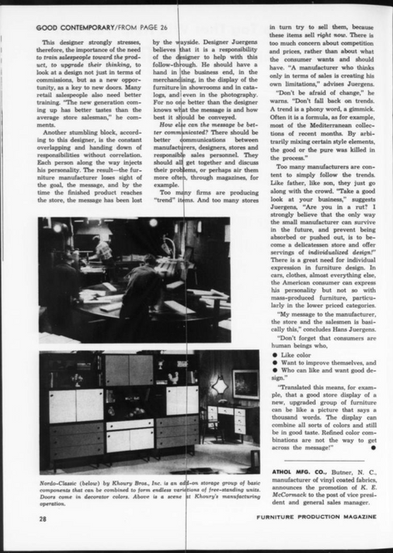The Grete Jalk sled chair - a tale of misattribution.
- Tim Hills
- Jan 26, 2021
- 3 min read
Updated: Feb 7, 2023

(Photo from Wright Auction online listing)
Several years ago, while researching Jerry Johnson's Sling Chair for Charlton, I found a grainy newspaper article that featured that chair's debut at the 1964 International Home Furnishings Market alongside another chair that has been a long time favorite, the so-called Grete Jalk Sled Chair.
To my surprise it was attributed to the Deco House Company.

Chicago Tribune, Jan 7, 1964.
This discovery made me reexamine the whole thing. The Grete Jalk attribution has been around for some time.
Grete Jalk
The top photo is from a Wright: Auction listing which even stated they were made by Poul Jeppesen in the 1960s, presumably linking it to Jalk's famous laminated chair produced by P.J. (a year earlier in 1963).
With its ingenious two piece design, this iconic chair harnesses the strength of bent plywood to create a chair that cradles the human form. The simple yet minimalist design and beauty of the teak veneer has earned the chair the 'Origami Chair' moniker.

Several other listings have repeated the misattribution of the sled based chair to Jalk, some hedging their bets with the phrase 'attributed to'. Some even wrongly identify the wood type as teak in an effort to make it fit the supposed Danish origins. (Walnut is much more typical for American-made chairs).
The Clincher
After looking on and off again for several years (I know, I'm obsessed!), I precipitously came across an print advert for the chair in House and Garden magazine, March 1964... and it even listed the designer, Hans Juergens!

Who was Deco House?
Hardly a household name now, Deco House Company was based in Birmingham Alabama and made a range of contemporary furniture in the 1960s, many seemingly 'in the style of' pieces such as the Adrian Pearsall style sofa in the advert below.

(The Tennessean July 31st, 1965)
Here is another advert, this time from House Beuatiful's June 1964 issue showing other models in the Elegante Collection:

A high back upholstered variation of the sled chair surfaced online in 2019:
Below is a sofa I believe to be a version of the sled base chair at auction recently, described as a Danish Modern Teak Sofa. Although it is not labeled, the sled base profile is unmistakable.
Below is a Deco House labeled lounge chair with a sculptural walnut base and expressive seat form that was shared online recently.
Another Labeled Deco House chair was auctioned in March of 2020. View the listing here.
This chair on a sled base is particularly interesting to me as it appears to use a modified version of the plywood shell that is part of the Galloway's Malabar Chair designed by Mel Abitz. Read more about that great chair here.
Designer
Deco House appears to have primarily employed freelance designers and this fascinating article from the Birmingham News (Sep 16th 1953) gives some background on Hans Juergens. A Chicago based designer, he had emigrated from Eastern Germany, studied at the Illinois Institute of Technology's Institute of Design and was employed by Deco House from 1963-1965.
Added Feb7 2023:

Source: Furniture Production March 1964
Added Feb7 2023:
Feature on Juergens and the Deco House chair in Furniture Production July, 1965
(Click and Scroll to read entire article)

Another article on Juergens, this time from the Chicago Tribune, May 19th 1963:



Another notable design by Juergens:

Interestingly there is a listing on ebay right now (Jan 2021) for a 3 bay unit of Holi Poli:
Deco House chair variants and construction
The Deco House chairs come in two forms, one with back braces and one without. While both have bent plywood shells faced in walnut veneer, only the first always has a solid walnut frame. The second appears to sometimes be elm with a tinted lacquer finish. Some shells also appear to not be veneered in walnut. We could refer to this as a budget version. The simple plywood shells are sturdy enough to not cause problems but many examples of these chairs have metal T braces on the inside of both sled to leg joints, suggesting a design and build weakness.
Type 1.


Type 2.

Another designer employed by Deco House
In 1966, prolific industrial designer Henry Glass designed a line of bent plywood furniture for Deco House called Intimate Island.

Interestingly, when I saw this drawing of a prototype chair from 1966 by Henry P. Glass I noted the similar plywood shells and the plywood links between them. Perhaps this was Glass developing an armed version for Deco House after the success of their armless one?

Links between the designers.
Both Juergens and Glass were Chicago based and probably even knew each other as they were both European immigrants active in the design world. Interestingly, they were both interviewed for this article below:


















































































